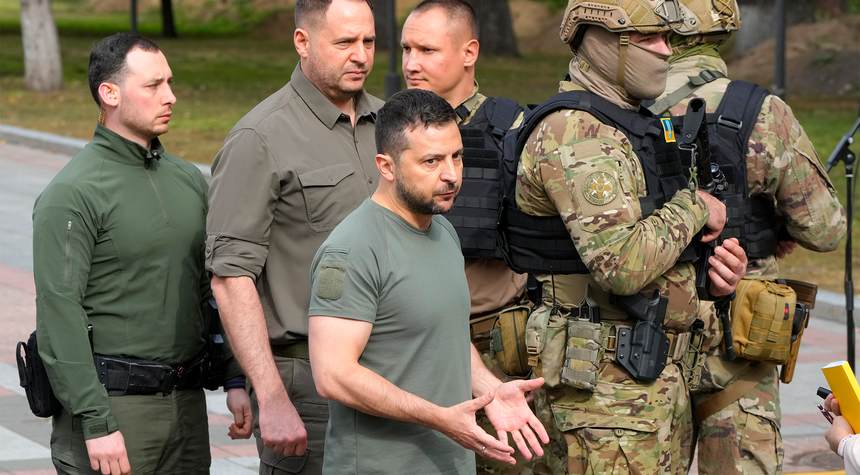On Friday, Human Rights Watch (HRW) revealed new evidence that Ukrainian forces are indiscriminately using banned anti-personnel landmines against Russia’s troops. This comes one day after Ukrainian officials decried the ecological impacts of landmines found across 30 percent of the country’s land in a meeting attended by Swedish climate change activist Greta Thunberg.
In a statement, Human Rights Watch’s arms director Steve Goose called on Ukraine to keep a commitment made earlier this month to “duly study” the group’s report. Goose said:
The Ukrainian government’s pledge to investigate its military’s apparent use of banned anti-personnel mines is an important recognition of its duty to protect civilians. A prompt, transparent, and thorough inquiry could have far-reaching benefits for Ukrainians both now and for future generations
HRW published a report on the use of the weapons in January and wrote the Ukrainian government about its findings in a letter in May, to which the organization received no response. Goose said:
Ukrainian forces appear to have extensively scattered landmines around the Izium area, causing civilian casualties and posing an ongoing risk. Russian forces have repeatedly used antipersonnel mines and committed atrocities across the country, but this doesn’t justify Ukrainian use of these prohibited weapons.
Russia’s Noncompliance With Mine Ban Treaty and Ukraine’s Alleged Violation
Ukraine signed the International Mine Ban Treaty of 1997 on February 24, 1999. Ukraine ratified the treaty in 2005, which prohibits the use of anti-personnel mines and mandates that stockpiles of the weapons must be destroyed.
Russia has not joined the treaty, with HRW writing that its use of the weapons “violates international humanitarian law … because they are inherently indiscriminate.” In May, Goose said:
These weapons do not differentiate between combatants and civilians and leave a deadly legacy for years to come.
Since the beginning of the war in February 2022, HRW has published four reports regarding the use of 13 types of anti-personnel mines by Russian troops that have killed and injured civilians.
In June 2022, HRW believed that Ukraine was not using anti-personnel mines, writing:
Ukraine appears to be abiding by its obligations as a member of the international treaty prohibiting antipersonnel mines, which it ratified in December 2005.
The recent report builds on the January report, revealing that Ukrainian soldiers had launched rockets containing numerous PMF-1 mines, also called “petal” or “butterfly” mines, in Russian-occupied areas, specifically in and around the eastern city of Izium. This action took place between April and September 2022, during Kyiv’s successful recapture of the city.
According to the latest report, additional evidence emerged concerning Ukrainian forces’ use of anti-personnel mines surfacing in photographs shared online by an individual working in eastern Ukraine, showcasing warhead sections of Uragan 220mm rockets. Each of these rockets indiscriminately disperses 312 PFM-1S anti-personnel mines, the report says.
In handwritten notes attached to one warhead, the Ukrainian word for “from” was inscribed, followed by a Latin alphabet letter related to an organization in Kyiv, which the report did not name. The unidentified individual that leads the organization had made social media posts “indicating that they had donated funds to the Ukrainian military via a non-governmental organization (NGO).”
A second Ukranian-based group posted photographs of Uragan warheads online bearing similar messages written in Ukrainian. HRW determined that the markings on the weapons specify the same batch, year, and factory. The report indicated that the handwriting, along with phrases, also matched.
Ukraine’s Double Standard
On Thursday, RedState reported on the environmental working group’s inaugural meeting in Kyiv, which was attended by Greta Thunberg:
The Ukrainian Ministry of Foreign Affairs reports that 174,000 square kilometers of land are contaminated by mines and unexploded bombs, making Ukraine the country with the most landmines in the world, ahead of Syria and Afghanistan. In a Twitter post about the working group meeting, Andriy Kostin, Prosecutor General of Ukraine, wrote that approximately 30 percent of Ukraine’s territory is contaminated with explosive objects.
In his post, the Prosecutor General also wrote, “We call for strengthening international efforts to investigate and prosecute Russia’s war crimes against the environment.”
Ukraine should have been concerned for the treaty it is alleged to be violating; as it loudly condemns the acts of Russia, it seems to ignore its own.

